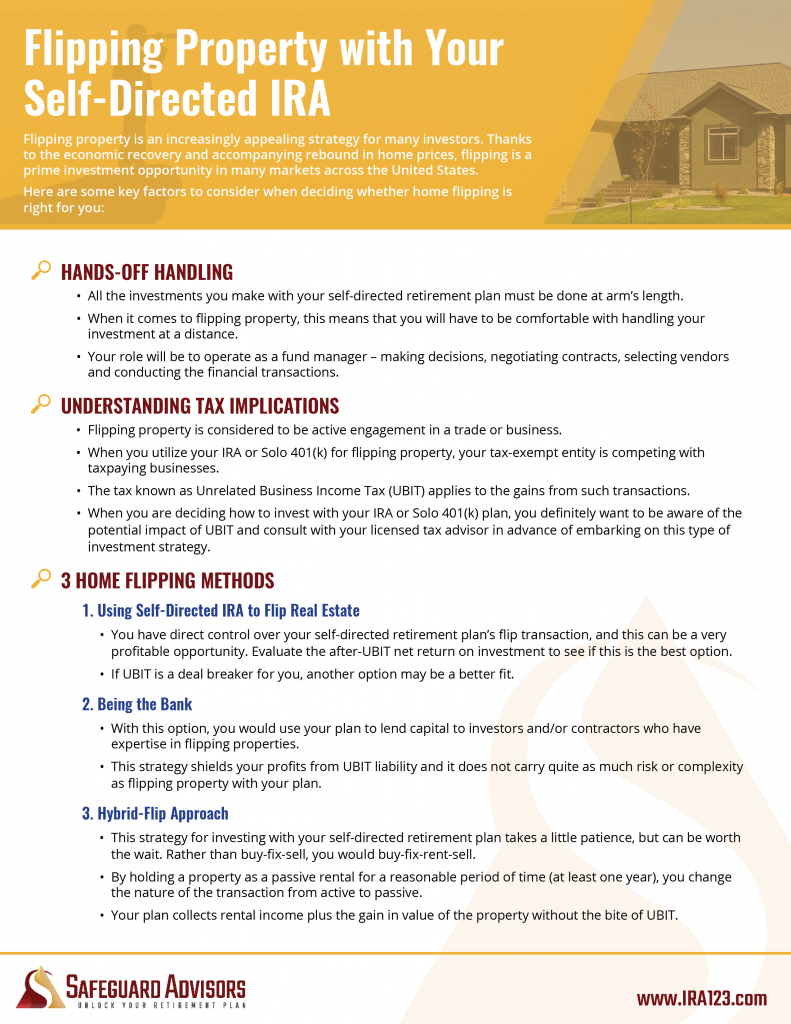Real Estate 201: Flipping Property with Your Self-Directed IRA [CHECKLIST]
Flipping property is an increasingly appealing strategy for many investors. Thanks to the economic recovery and accompanying rebound in home prices, as well as the slowdown in new-home construction, flipping is a prime investment opportunity in many markets across the United States. There is good money to be made in the business of acquiring homes that are distressed (either in physical condition or financing circumstances), rehabilitating those homes, and then reselling them to someone wanting to live in the property, or even to another investor looking for a cash-flow rental property.

Fortunately, as an investor with a self-directed IRA or Solo 401(k) plan, you are poised to take excellent advantage of this kind of opportunity. The flexibility of your self-directed retirement plan enables you to invest in a wide array of asset classes and to diversify into opportunities beyond the confines of the stock market, and flipping property is an area where you can use your self-directed retirement plan to earn superior returns.
As our title (Real Estate 201) suggests, flipping property is a more advanced strategy for IRA or 401(k) investors, and there are some key factors to consider when deciding whether it is right for you.
Hands-off Handling
All the investments you make with you self-directed retirement plan must be done fully at arm’s length. When it comes to flipping property, this means that you will have to be comfortable with handling your investment at a distance. Your role will be to operate as a fund manager; making decisions, negotiating and executing contracts, selecting vendors, and conducting the financial transactions associated with deploying your IRA or 401k capital into such a project. However, you cannot be directly involved in a hands-on sense, such as serving as contractor or adding value through sweat equity of your own.
Understanding the Tax Implications
For tax purposes, strategies such as holding rental properties or investing in the stock market are considered to be passive investments, whereas flipping property is considered to be active engagement in a trade or business. As such, there are tax implications to consider when you are deciding if it is the right strategy for you.
Your IRA or Solo 401(k) is a tax-exempt entity. When you utilize it for flipping property, your tax-exempt entity is competing with taxpaying businesses. There is a tax known as Unrelated Business Income Tax (UBIT) that applies to the gains from such transactions. This tax is meant to level the playing field and prevent tax-exempt entities from driving taxpaying entities out of business.
Of course, the first step is to assess whether or not this tax will apply to your investments. The UBIT applies when a tax-exempt entity engages in a trade or business on a regular or repeated basis. Unfortunately, since the language of the tax code does not explicitly tell us what constitutes “regular or repeated”, this can be difficult to discern. The topic is much debated in the tax-planning and real estate communities, and you will find a range of opinions regarding the transaction frequency at which the UBIT begins to apply, from “more than one,” to “fewer than three to five” flips per year.
Ultimately, the applicability of UBIT is at the discretion of the IRS. The tax code allows the IRS to consider the specifics of each individual case and to make a determination regarding whether the investment activity taking place is subject to UBIT. When making such a determination, they will look at factors such as intent, speed and frequency of transactions, marketing of property for sale, etc., and use the information to distinguish between passive investment in property deals and being in the business of redeveloping and reselling properties.
When you are deciding how to invest with your IRA or Solo 401(k) plan, you definitely want to be aware of the potential impact of the UBIT and consult with your licensed tax advisor in advance of embarking on this type of investment strategy.
However, even with exposure to UBIT, the net gains from flipping properties with your retirement plan can be quite substantial. There are potential costs associated with any investment activity. If you can flip property, pay the tax, and still realize a superior ROI for your investment dollars, your investment is a success. At the end of the day, the UBIT is just another cost of doing business, and it shouldn’t deter you from favorable investment opportunities.
Rather than having the IRA directly flip properties and have exposure to UBIT, there are other strategies such as lending to flippers that are passive in nature and therefore not subject to this tax. As such, there are different ways you can approach flip opportunities with your self-directed IRA or Solo 401(k) plan. There are three primary methods that we will consider:
- Using Your Self-Directed IRA to Flip Real Estate
- Being the Bank
- The Hybrid-Flip Approach
Each of these methods has specific advantages and disadvantages, but if executed properly, they can all produce better than average returns for your retirement plan.
Take a look at our helpful checklist below and download the PDF.

Photo by Tami Hills via CC license
Talk to An Expert Today!
Learn these little known strategies and tactics, and unlock your retirement plan today.
